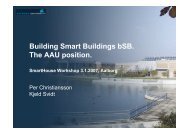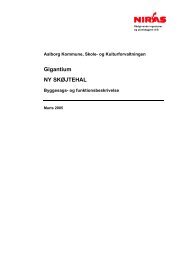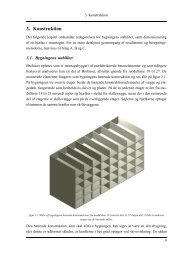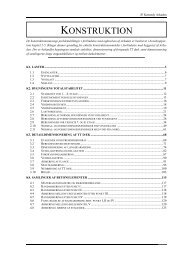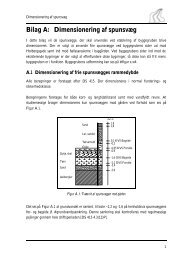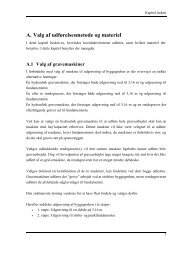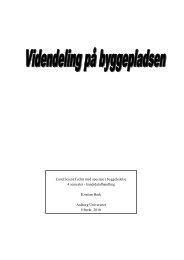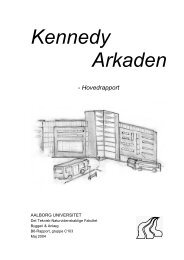Abstract Keywords Introduction - IT in Civil Engineering. Aalborg ...
Abstract Keywords Introduction - IT in Civil Engineering. Aalborg ...
Abstract Keywords Introduction - IT in Civil Engineering. Aalborg ...
- No tags were found...
You also want an ePaper? Increase the reach of your titles
YUMPU automatically turns print PDFs into web optimized ePapers that Google loves.
FROM PAPER TO HYPERSPACE. REPRESENTING AND HANDLING KNOWLEDGEIN AN INTERACTIVE MEDIA ENVIRONMENT<strong>Abstract</strong>The systems we are formulat<strong>in</strong>g today may provide us withdramatically better communication tools as communication rooms,personal "telescreens", and virtual realities. Beh<strong>in</strong>d thesystem <strong>in</strong>terfaces dwell more and more capable knowledgerepresentations which are closely related to pert<strong>in</strong>ent searchstrategies. What are the implications of the mutual <strong>in</strong>fluencebetween user demands and <strong>in</strong>formation technology? What will theproperties and impact be of the next generations <strong>in</strong>formationhandl<strong>in</strong>g system? It is now possible to create models whichbr<strong>in</strong>g about a clearer and more obvious connection between theapplications, our <strong>in</strong>tentions and the computer stored models. Aswe mix knowledge representations which more or less formalizethe models we create of our reality we can provide the userswith specified views and tools on different levels ofabstraction and degree of formalization. We must formulate andtry out new concepts. New tools for build<strong>in</strong>g and us<strong>in</strong>g the nextgeneration systems have been def<strong>in</strong>ed, created and tested at theKBS-MEDIA LAB (knowledge based system - media) at LundUniversity. Examples and scenarios are given at the symposiumoutgo<strong>in</strong>g from projects carried through <strong>in</strong> the KBS-MEDIAenvironment which is shortly characterized as a multi agentenvironment with multimedia context dependent user <strong>in</strong>terfacesto underly<strong>in</strong>g facts bases.<strong>Keywords</strong>Per Christiansson, Ph.D., Assoc. Prof.Department of Structural Eng<strong>in</strong>eer<strong>in</strong>gLund Institute of technology. Lund UniversityBox 118, 221 00 Lund, SwedenAugust 1991Communication; <strong>in</strong>teractive media; agents; man-mach<strong>in</strong>e <strong>in</strong>teraction;knowledge representation; hypermedia; artificial <strong>in</strong>telligence<strong>Introduction</strong>Information must onwards be regarded as a resource like labour,capital, property/product/material and energy. New system conceptsfor handl<strong>in</strong>g and represent<strong>in</strong>g knowledge must be formulatedand tried out <strong>in</strong> theoretical and practical trials. It isvery important that we try to transmit possible efficiencyga<strong>in</strong>s to someth<strong>in</strong>g that will raise quality on both our work environment,cooperation possibilities and the end result of ourefforts.For examplewe can now focus on; dynamically establish net-13rd International Symposium on "Systems Research, Informatics and Cybernetics".Baden-Baden, Germany. Agust 12-18, 1991
DEMANDSAPPLICATIONS<strong>IT</strong>, InformationTechnologyFigure 1. There isa necessary mutual<strong>in</strong>fluence betweenthe applicationsand <strong>in</strong>formationtechnology doma<strong>in</strong>sfor short and longterm problem solutions.works, access, collect and handle very large <strong>in</strong>formation volumes,def<strong>in</strong>e new tools to use, build, and ma<strong>in</strong>ta<strong>in</strong> the systems,create new ways to def<strong>in</strong>e detail levels/resolution when access<strong>in</strong>gthe models through "connectionist" th<strong>in</strong>k<strong>in</strong>g (that is to dynamicallyconnect knowledge chunks <strong>in</strong> vary<strong>in</strong>g patterns), mixknowledge representations, create adapted user views, createeasily understandable and <strong>in</strong>teractive systems on applicationlevels. See also figures 2-5.Communication environmentFrom (Christiansson, 1990a). "The computer systems of tomorrowwill conta<strong>in</strong> huge and complex <strong>in</strong>formation volumes. Issues concern<strong>in</strong>gcommunication with the systems will be very essential.We will be able to search multi-dimensional spaces (room, time,resolution, etc.), see figure 6. Dependent on who is <strong>in</strong>teract<strong>in</strong>gwith the system and <strong>in</strong> what context it is done the searchmechanisms will be different:"Man orMach<strong>in</strong>eaccessSpeech/languagesoundimagetextdraw<strong>in</strong>ganimationfilm/videotactileMEDIUMMEDIUMCAPTUREDELIVERYStandardsBandwidthAvailabilityMediumSTOREMANIPULATETRANSFERPer Christiansson 1986Conta<strong>in</strong>smodels of:ApplicationsProductsProcessesUsersManMach<strong>in</strong>eToolsusebuildma<strong>in</strong>ta<strong>in</strong>Figure 2. Information flowas l<strong>in</strong>ked processes on differentlevels.2
Figure 8. Logical structureof the 'DELPHI'demonstration system.Three layers can be seen:the context level with itsdifferent views (repair,hire, etc..) to the system,facts bases andtools/background agentswith <strong>in</strong>termediate shorttermmemory/"note-book".From (Christiansson,1990d).model will be and less flexible to changes. It is of course aquestion about optimiz<strong>in</strong>g <strong>in</strong> a set of constra<strong>in</strong>ts as ease ofsystem ma<strong>in</strong>tenance, and flexibility to new type of projectsetc. (see also figure 7).The KBS-MEDIA LABS<strong>in</strong>ce the autumn 1987 the author have been responsible forbuild<strong>in</strong>g up the KBS-MEDIA (Knowledge-based Systems - Media)environment at the department of Structural eng<strong>in</strong>eer<strong>in</strong>g at LundUniversity. Demonstration systems have been and are built toFigure 9. A work station <strong>in</strong> the KBS-MEDIA laboratory. MacIIcomputer, B&W scanner, video camera, videodisk player, TVmonitor (also displayed on the computer screen), and opticaldiscs and audio <strong>in</strong>put. CD-ROM player and removable hard diskunits are not shown <strong>in</strong> the picture.5



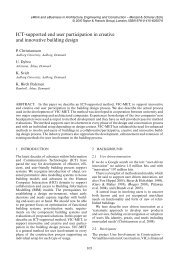
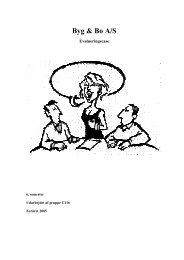
![[abs ID] PAPER TITLE - IT in Civil Engineering. Aalborg University](https://img.yumpu.com/51222254/1/184x260/abs-id-paper-title-it-in-civil-engineering-aalborg-university.jpg?quality=85)
